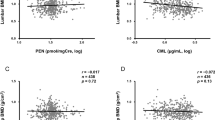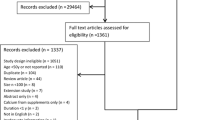Abstract
Objective: To investigate plasma osteocalcin γ-carboxylation and its relationship to plasma phylloquinone concentration and apolipoprotein E (apoE) genotype in women from three ethnic groups with differing osteoporotic fracture risk.
Design and subjects: Fasted blood samples were collected from postmenopausal Gambian (n=50), British (n=31) and Chinese women (n=23), and 11 premenopausal women in each group from three cross-sectional studies.
Results: After adjustment for total osteocalcin, plasma undercarboxylated osteocalcin (adjusted ucOC) was lowest in Chinese and highest in British women postmenopause (British vs Chinese 103% higher, P<0.0001; Gambian vs Chinese 66% higher, P<0.01). No differences were observed premenopause. Within each ethnic group, adjusted ucOC was similar pre- and postmenopause. Postmenopause, plasma phylloquinone was higher in Chinese women (1.0 ng/ml) than in British (0.31 ng/ml) and Gambian women (0.36 ng/ml) (P<0.0001). Premenopause, plasma phylloquinone was higher in Gambian and Chinese women (0.6 ng/ml) than in British women (0.3 ng/ml; P=0.01). Plasma phylloquinone and adjusted ucOC were inversely related in postmenopausal British women (R2=32.4%; P=0.0008). ApoE4 frequency was Gambian 32.6%, British 13.8% and Chinese 6%. A lower adjusted ucOC was associated with apoE2 genotype in British and Chinese women. Ethnic differences in adjusted ucOC persisted after adjustment for phylloquinone and apoE genotype.
Conclusion: These preliminary data indicate suboptimal vitamin K status in postmenopausal British compared to Chinese and Gambian women. Ethnic differences in apoE genotype may also influence osteocalcin γ-carboxylation status. The study highlights the need for larger epidemiological investigations of ethnic differences in vitamin K status and the possible implications to bone health.
Sponsorship: This work was funded by the MRC.
This is a preview of subscription content, access via your institution
Access options
Subscribe to this journal
Receive 12 print issues and online access
$259.00 per year
only $21.58 per issue
Buy this article
- Purchase on Springer Link
- Instant access to full article PDF
Prices may be subject to local taxes which are calculated during checkout


Similar content being viewed by others
References
Adebajo AO, Cooper C & Evans JG (1991): Fractures of the hip and distal forearm in West Africa and the United Kingdom. Age Ageing 20, 435–438.
Aspray TJ, Prentice A, Cole TJ, Sawo Y, Reeve J & Francis RM (1996): Low bone mineral content is common but osteoporotic fractures are rare in elderly rural Gambian women. J. Bone Miner. Res. 11, 1019–1025.
Binkley NC & Suttie JW (1995): Vitamin K nutrition and osteoporosis. J. Nutr. 125, 1812–1821.
Bitensky L, Hart JP, Catterall A, Pilkington MJ & Chayen J (1988): Circulating vitamin K levels in patients with fractures. J. Bone Joint Surg. 70-B, 663–664.
Booth SL, Sokoll LJ, O'Brien ME, Tucker K, Dawson-Hughes B & Sadowski JA (1995): Assessment of dietary phylloquinone intake and vitamin K status in postmenopausal osteoporosis. Eur. J. Clin. Nutr. 49, 832–841.
Booth S, Pennington J & Sadowski J (1996): Food sources and dietary intakes of vitamin K1 (phylloquinone) in the American diet: data from the FDA Total Diet Survey. J. Am. Diet Assoc. 96, 149–154.
Booth SL, Tucker KL, McKeown NM, Davidson KW, Dallal GE & Sadowski JA (1997): Relationships between dietary intakes and fasting plasma concentrations of fat-soluble vitamins in humans. J. Nutr. 127, 587–592.
Booth SL, O'Brein-Morse ME, Dallal GE, Davidson KW & Gundberg CM (1999): Response of vitamin K status to different intakes and sources of phylloquinone-rich foods: comparison of younger and older adults. Am. J. Clin. Nutr. 70, 368–377.
Booth SL, Tucker KL, Chen HL, Hannan MT, Gagnon DR, Cupples LA, Wilson PWF, Ordovas J, Schaefer EJ, Dawson-Hughes B & Kiel DP (2000): Dietary vitamin K intakes are associated with hip fracture but not with bone mineral density in elderly men and women. Am. J. Clin. Nutr. 71, 1201–1208.
Cauley JA, Zmuda JM, Yaffe K, Kuller LH, Ferrell RE, Wisniewski SR & Cummings SR (1999): Apolipoprotein E polymorphism: a new genetic marker of hip fracture risk—the study of osteoporotic fractures. J. Bone Miner. Res. 14, 1175–1181.
Cullen P, Cignarella A, Brennhausen B, Mohr S, Assmann G & von Eckardstein A (1998): Phenotype-dependent differences in apolipoprotein E metabolism and in cholesterol homeostasis in human monocyte-derived macrophages. J. Clin. Invest. 101, 1670–1677.
Cummings SR, Cauley JA, Palmero L, Ross PD, Wasnich RD, Black D & Faulkner KG (1994): Racial differences in hip axis lengths might explain differences in rates of hip fracture. Osteoporosis Int. 4, 226–229.
Davidson KW & Sadowski JA (1997): Determination of vitamin K compounds in plasma or serum by high-performance liquid chromatography using postcolumn chemical reduction and fluorometric detection. Methods Enzymol. 282, 408–421.
Davignon J, Gregg RE & Sing CF (1988): Apolipoprotein E polymorphism and atherosclerosis. Atherosclerosis 18, 1–21.
Dowd P, Ham S-W, Naganathan S & Hershline R (1995): The mechanism of action of vitamin K. Ann. Rev. Nutr. 15, 419–440.
Ferland G, Sadowski JA & O'Brein ME (1993): Dietary induced vitamin K deficiency in normal human subjects. J. Clin. Invest. 91, 1761–1768.
Gundberg CM, Nieman SD, Abrams S & Rosen H (1998): Vitamin K status and bone health: an analysis of methods for determination of undercarboxylated osteocalcin. J. Clin. Endocrinol. Metab. 83, 3258–3266.
Hart JP, Shearer MJ, Klenerman L, Catterall A, Reeve J, Sambrook PN, Dodds RA, Bitensky L & Chayen J (1985): Electrochemical detection of depressed circulating levels of vitamin K1 in osteoporosis. J. Clin. Endocrinol. Metab. 60, 1268–1269.
Heikkinen AM, Kroger H, Niskanen L, Komulainen MH, Ryynanen M, Parviainen MT, Tuppurainen MT, Honkanen R & Saarikoski S (2000): Does apoliopoprotein E genotype relate to BMD and bone markers in postmenopausal women? Maturitas 34, 33–41. 2000.
Knapen MHJ, Hamulyak K & Vermeer C (1989): The effect of vitamin K supplementation on circulating osteocalcin (bone Gla protein) and urinary calcium excretion. Ann. Intern. Med. 111, 1001–1005.
Knapen MHJ, Jie K-S, G, Hamalyak K & Vermeer C (1993): Vitamin K-induced changes in markers for osteoblast activity and urinary calcium loss. Calcif. Tissue Int. 53, 81–85.
Kohlmeier M, Saupe J, Shearer MJ, Schaefer K & Asmus G (1997): Bone health of adult hemodialysis patients is related to vitamin K status. Kidney Int. 51, 1218–1221.
Kohlmeier M, Saupe J, Schaefer K & Asmus G (1998): Bone fracture history and prospective bone fracture risk of hemodialysis patients are related to apolipoprotein E genotype. Calcif. Tissue Int. 62, 278–281.
Lamon-Fava S, Sadowski JA, Davidson KW, O'Brein ME, McNamara JR & Schaefer EJ (1998): Plasma lipoproteins as carriers of phylloquinone (vitamin K1) in humans. Am. J. Clin. Nutr. 67, 1226–1231.
Lau EMC & Cooper C (1996): The epidemiology of osteoporosis: the Oriental perspective in a world context. Clin. Orthop. 323, 65–74.
Mahley RW & Hussain MM (1991): Chylomicron and chylomicron remnant catabolism. Curr. Opin. Lipidol. 2, 170–176.
McCarthy PT, Harrington DJ & Shearer MJ (1997): Assay of phylloquinone in plasma by high-performance liquid chromatography with electrochemical detection. Methods Enzymol. 282, 421–433.
Merle D & Delmas PD (1990): Normal carboxylation of circulating osteocalcin in Paget's disease of the bone. Bone Miner. 11, 237–245.
Newman P, Bonello F, Wierzbicki AS, Lumb P, Savidge GF & Shearer MJ (2002): The uptake of lipoprotein-borne phylloquinone (vitamin K1) by osteoblasts and osteoblast-like cell: role of heparan sulfate proteoglycans and apolipoprotein E. J. Bone Miner. Res. 17, 426–433.
Plantalech L & Guillamont M (1991): Impairment of gamma carboxylation of circulating osteocalcin (bone Gla protein) in elderly women. J. Bone Miner. Res. 6, 1211–1216.
Prentice A, Shaw J, Laskey MA, Cole TJ & Fraser DR (1991): Bone mineral content of British and rural Gambian women aged 18–80+ years. Bone Miner. 12, 201–214.
Prentice A, Parsons TJ & Cole TJ (1994): Uncritical use of bone mineral density in absorptiometry may lead to size-related artifacts in the identification of bone mineral determinants. Am. J. Clin. Nutr. 60, 837–842.
Prentice A, Yan L, Beavan S, Dibba B, Aspray T, Stirling D, Laskey MA & Ginty F (2001): Differences in markers of calcium metabolism and bone turnover in young and old British, Chinese and Gambian women. Ann. Nutr. Metab. 45, 247.
Price PA, Williamson MK & Lothringer JW (1981): Origin of the vitamin K-dependent bone protein found in plasma and its clearance by kidney and bone. J. Biol. Chem. 256, 12760–12766.
Roberts NB, Holding JD, Walsh HPJ, Klenerman L, Helliwell T, King D & Shearer M (1996): Serial changes in serum vitamin K, triglyceride, cholesterol, osteocalcin and 25-hydroxyvitamin D in patients after hip replacement for fractured neck of femur or osteoarthritis. Eur. J. Clin. Invest. 26, 24–29.
Sadowski JA, Hood SJ, Dallal GE & Garry PJ (1989): Phylloquinone in plasma from elderly and young adults: factors influencing its concentration. Am. J. Clin. Nutr. 50, 100–108.
Saupe J, Shearer MJ & Kohlmeier M (1993): Phylloquinone transport and its influence on gamma-carboxyglutamate residues of osteocalcin in patients on maintenance hemodialysis. Am. J. Clin. Nutr. 58, 204–208.
Shiraki M, Shiraki Y, Aoki C, Hosoi T, Inoue S, Kaneki M & Ouchi Y (1997): Association of bone mineral density with apolipoprotein E phenotype. J. Bone Miner. Res. 12, 1438–1445.
Shiraki M, Shiraki Y, Aoki C & Miura M (2000): Vitamin K2 (menatetrenone ) effectively prevents fractures and sustains lumbar bone mineral density in osteoporosis. J. Bone Miner. Res. 15, 515–521.
Sokoll LJ & Sadowski JA (1996): Comparison of biochemical indexes for assessing vitamin K nutritional status in a healthy adult population. Am. J. Clin. Nutr. 63, 566–573.
Sokoll LJ, Booth SL, O'Brein ME, Davidson KW, Tsaioun KI & Sadowski JA (1997): Changes in serum osteocalcin, plasma phylloquinone, and urinary gamma-carboxyglutamic acid in response to altered intakes of dietary phylloquinone in human subjects. Am. J. Clin. Nutr. 65, 779–784.
Solomon L (1968): Osteoporosis and fracture of the femoral neck in the South African Bantu. J Bone Joint Surg. 50B, 2–13.
Suttie JW, Mummah-Schendel LL, Shah DV, Lyle BJ & Greger JL (1988): Vitamin K deficiency from dietary vitamin K restriction in humans. Am. J. Clin. Nutr. 47, 475–480.
Szulc P, Chapuy M-C, Meunier PJ & Delmas PD (1993): Serum undercarboxylated osteocalcin is a marker of the risk of hip fracture in elderly women. J. Clin. Invest. 91, 1769–1774.
Wenham PR, Price WH & Blundell G (1991): Apolipoprotein E genotyping by one-stage PCR. Lancet 337, 1158–1159.
Vergnaud P, Garnero P, Meunier PJ, Breart G & Delmas PD (1997): Undercarboxylated osteocalcin measured with a specific immunoassay predicts hip fracture in elderly women. J. Clin. Endocrinol. Metab. 82, 719–724.
Yan L, Zhou B, Prentice A, Wang X & Golden MH (1999): Epidemiological study of hip fracture in Shenyang, People's Republic of China. Bone 24, 151–155.
Yan L, O'Neill A, Zhou B, Greenberg D C, Prynne C J, Bolton-Smith C & Prentice A (2002): A comparison of the estimated vitamin K1 intake in older people from Cambridge, UK and Shenyang, PR China. Proc. Nutr. Soc. 61, 149A.
Author information
Authors and Affiliations
Corresponding author
Additional information
Guarantor: A Prentice.
Contributors: SB was responsible for manuscript preparation, laboratory analyses, data interpretation and sample collection in UK and Gambia. AP was responsible for supervision, overall coordination of the study and participated in data analysis, interpretation of results and preparation of manuscript. DMS and DJH participated in laboratory analyses. BD coordinated subject recruitment in The Gambia. LY coordinated subject recruitment and sample collection in China. MJS participated in data interpretation and preparation of manuscript.
Rights and permissions
About this article
Cite this article
Beavan, S., Prentice, A., Stirling, D. et al. Ethnic differences in osteocalcin γ-carboxylation, plasma phylloquinone (vitamin K1) and apolipoprotein E genotype. Eur J Clin Nutr 59, 72–81 (2005). https://doi.org/10.1038/sj.ejcn.1602037
Received:
Revised:
Accepted:
Published:
Issue Date:
DOI: https://doi.org/10.1038/sj.ejcn.1602037
Keywords
This article is cited by
-
The serum undercarboxylated osteocalcin level and the diet of a Japanese population: results from the Kyushu and Okinawa Population Study (KOPS)
Endocrine (2013)
-
Association between vitamin K intake from fermented soybeans, natto, and bone mineral density in elderly Japanese men: the Fujiwara-kyo Osteoporosis Risk in Men (FORMEN) study
Osteoporosis International (2012)
-
High prevalence of vitamin K and D deficiency and decreased BMD in inflammatory bowel disease
Osteoporosis International (2009)
-
Low plasma phylloquinone concentration is associated with high incidence of vertebral fracture in Japanese women
Journal of Bone and Mineral Metabolism (2008)



